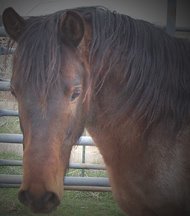Take Consolation, for instance. I posted earlier in the week about how, on her taxi ride, I sensed that she was still hovering to close to the brink of taking control. She stayed with me for that ride, but as her confidence in balancing a rider grows, her lead mare tendencies bubble closer to the surface. She demonstrated that she was willing to almost ignore rein cues if doing so suited her fancy, and I wondered if one good spook or surge of frolic would send her flying for home -- rider optional.
The issue with Consolation one of leadership. This is the sticking point I must address before we can really move out on the trails. It seems to me that her unique "problem" -- which is really a hallmark of courage and high intelligence -- is that she needs a good reason to listen to me. So, I thought up a way to give her one.
 For the past several days, I've been setting up obstacle courses of ground poles in the round corral. First walking, then trotting, we weave through, over, and around the poles in random patterns that require Consolation's constant attention. To navigate the obstacles, she must listen and respond quickly. She's already demonstrating vast improvement, softening physically and mentally as she gets into the game.
For the past several days, I've been setting up obstacle courses of ground poles in the round corral. First walking, then trotting, we weave through, over, and around the poles in random patterns that require Consolation's constant attention. To navigate the obstacles, she must listen and respond quickly. She's already demonstrating vast improvement, softening physically and mentally as she gets into the game.Soon, before she gets bored, I'll throw in some extras: a tarp under some of the poles. construction cone with a jacket draped over it, maybe even a tiny crossbar. The point is to keep her thinking, listening, and responding -- all skills that will translate to better communication next time we hit the road.
Good training is about knowing your horse as an individual, developing the ability to diagnose the root cause of a behavioral symptom, and applying custom-designed solutions.
Oh, and there's nothing like a post-ride pedicure to keep a lady feeling special.
 By the way, the most observant among you will have noticed that I've switched Consolation from the Dr. Cook's Bitless Bridle (sales-pitchy website alert!) to a full-cheek, single-joined snaffle. This is not because I felt the need for something harsher, but rather because Consolation displayed pronounced distaste for the "head-hugging" action of the bitless bridle. For her, the snaffle seems a less intrusive option. Aaruba, on the other hand, loves that bitless bridle. Proof, once again, that a horse is not [just another] horse (of course)!
By the way, the most observant among you will have noticed that I've switched Consolation from the Dr. Cook's Bitless Bridle (sales-pitchy website alert!) to a full-cheek, single-joined snaffle. This is not because I felt the need for something harsher, but rather because Consolation displayed pronounced distaste for the "head-hugging" action of the bitless bridle. For her, the snaffle seems a less intrusive option. Aaruba, on the other hand, loves that bitless bridle. Proof, once again, that a horse is not [just another] horse (of course)!_____________________________________
Related Posts
Breaking Free: Training the Herdbound Horse
Where To, Ma'am: First Trail Ride on a Green Horse
Connecting the Dots: Breakthroughs in Horse Training
Moving Out: Increasing Speed and Confidence on the Trail
_____________________________________
Want to read more posts like this one? We deliver!









1 comment:
Consolation is a beautiful mare. You can see how intelligent she is just looking at pictures.
It's fascinating how horses respond differently to head gear. My mare hates bits, period. She's a very strong, forward mare, but yet her favored headgear is a lightweight, beta-noseband S hack. Put her in that and she's soft and light. She's definitely told me that she doesn't like anything in her tiny little mouth, so I can really appreciate your take on this topic.
Post a Comment